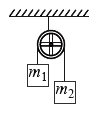A fixed pulley carries a weightless thread with masses m2andm1 at its ends (m2>m1). There is friction between the thread and the pulley. If it is such that the thread starts slipping when the ratio of m2 to m1 is n0. Find :
(a) the friction coefficient
(b) the acceleration of the masses when m2m1=n>n0
[Hint : Consider an element of the thread of width dθ at angular distance θfrom the horzontal diameter of the pulley. The forces at the ends are T and T = dT. If dN is the normal reaction of the pulley on the element than df (frictional force on the element) =μdN Resolving the tensions at the ends along and perpendicular to the radius vector of the element, we have for equilibrium of the element dT=dfanddN=Tdθ Integrate from T1 to T2.T1=m1gandT2=m2g. These are obtained by considering equilibrium of m1andm2]
The correct Answer is:μ−lnn0πa=g(n−n0)(n+n0)
Topper's Solved these Questions
- FRICTION, WORK POWER AND ENERGYBook:NN GHOSHChapter:FRICTION, WORK POWER AND ENERGYExercise:Exercises (A)
Explore 15 Videos
- FIRST LAW OF THERMODYNAMICSBook:NN GHOSHChapter:FIRST LAW OF THERMODYNAMICSExercise:All Questions
Explore 39 Videos
- GRAVITATIONBook:NN GHOSHChapter:GRAVITATIONExercise:EXERCISE
Explore 29 Videos
Similar Questions
A block weighing 5 kg is pressed against a verticalk wall by a normal force of 150 N the coefficient of friction along being 0.5 . Find the force required to cause the block to move (a) horizontally, (b) vertically upward, (c) vertically downwards.
View SolutionA waterfall whose vertical height is 100m discharges water into a pool below the fall. Calculate the rise in temperature of water assuming that all the heat remains in the water. (Specific heat capacity of water =4200Jkg−1K−1)
View SolutionCalculate the acceleration due to gravity on the earth 's surface , given that gravitational constant G=6.7×10−11 SL unit , radius of he earth = 6.4×106m and mean density of earth = 5.5×103kgm−3.
View SolutionA pulley fixed to the ceiling carried a thread with bodies of masses m_(1) and m_(2) attached to its ends. The mases of the pulley and the thread are negligible and friction is absent. Find the acceleration of the centre of mass of this system.
View SolutionA pulley fixed to the ceiling carries a thread with bodies of masses m1 and m2 attached at its ends. The masses of the pulley and thread are negligible, friction is absent. Find the acceleration of the centre of mass(acm) of this system.
View SolutionFind the acceleration of m1 and m2 in an Atwood's Machine if there is friction present between surface of pulley and the thread and thread does not slip over the surface ofpulley. Moment of inertia of pulley is I.
View SolutionA fixed pulley carries a weightless thread with masses m1 and m2 at its ends. There is friction between the thread and the pulley. It is such that the thread starts slipping when the ratio m2/m1=η0 find :
(a) The friction coefficient
(b) The acceleration of the mass when m2/m1=η>η0
View SolutionIn the arrangement shown in fig the bodies have masses m_(0), m_(1) and m_(2) the friction is absent the masses of pulleys and the threads are negligible find the acceleration of the body m_(1)
View Solutionसूत्र (m1x2+m2x1m1+m2,m1y2+m2y1m1+m2) क्या कहलाता है ?
View SolutionTwo masses m1 and m2(m2>m1) are hanging vertically over frictionless pulley. The acceleration of the two masses is :

View SolutionIn the figure, the blocks have masses M_(1) and M_(2) (M_(1) gt M_(2)) and acceleration a. The pulley P has a radius r and some mass the string not slip on the pulley
View SolutionTwo masses m_(1) and m_(2) ( m_(2) gt m_(1)) are hanging vertically over frictionless pulley. The acceleration of the two masses is :
View SolutionA pulley fixed to the ceiling of an elevator car carries a thread whose ends are attached to the masses m_(1) and m_(2) . The car starts going up with an acceleration a_(0) . Assuming the masses of the pulley and the thread as well as the friction to be negligible, find: (a) the acceleration of the load m_(1) relative to the elevator shaft and relative to the car (b) the force exerted by the pulley on the ceiling of the car. Given m_(1) gt m_(2) .
View SolutionConsider the case of two bodies of masses m_(1) and m_(2) which are connected by light inextensible string passing over a light smooth pulley as shown in the figure. The expression for acceleration of the system and tension of the string are expressed below under different situations: (i) when m_(1) gt m_(2) . In this case a=((m_(1)-m_(2))/(m_(1)+m_(2)))g and T=((2m_(1)m_(2))/(m_(1)+m_(2)))g (ii) when m_(2) gt m_(1) . In this case a=((m_(2)-m_(1))/(m_(1)+m_(2)))g and T=((2m_(1)m_(2))/(m_(1)+m_(2)))g (iii) When m_(1)=m_(2)=m . In this case a = 0, T = mg If m_(1)=10kg, m_(2)=6kg and g =10m//s^(2) then what is the acceleration of masses?
View SolutionConsider the case of two bodies of masses m_(1) and m_(2) which are connected by light inextensible string passing over a light smooth pulley as shown in the figure. The expression for acceleration of the system and tension of the string are expressed below under different situations: (i) when m_(1) gt m_(2) . In this case a=((m_(1)-m_(2))/(m_(1)+m_(2)))g and T=((2m_(1)m_(2))/(m_(1)+m_(2)))g (ii) when m_(2) gt m_(1) . In this case a=((m_(2)-m_(1))/(m_(1)+m_(2)))g and T=((2m_(1)m_(2))/(m_(1)+m_(2)))g (iii) When m_(1)=m_(2)=m . In this case a = 0, T = mg If the pulley is pulled upward with acceleration equal to the acceleration due to gravity, what will be the tension in the string?
View Solution

